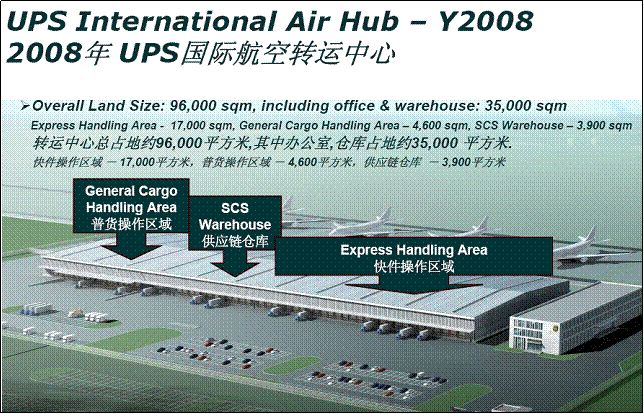UPS
What I Learned in China
November 18, 2009
By
Richard Armstrong
Key Personnel:
Anna Wang, Marketing
Melody Wong, Marketing
Michelle Yu, Manager – Contract Logistics
Stella Liu, Supervisor
Lilly Xu, Welcome Center Representative
UPS Express and UPS Supply Chain Solutions (SCS operations) are involved in a closely integrated expansion in China. Operations began in 1988 and UPS now has 5,500 employees. UPS serves in 45 locations that constitute more than 80% of China’s GDP (330 cities). There are 16 import and 17 export gateways. There are 144 UPS flights weekly including 12 chartered with Yangtze River Express. (UPS runs the ninth largest airline in the world in terms of IATA’s ranking on scheduled international freight tonne-kilometres flown in 2008).
On the ground, UPS runs 940 vehicles and operates 100 facilities. Operations are concentrated along the Eastern Seaboard. Not surprisingly, the major airport locations are Beijing, Shanghai, Qingdao, Guangzhou and Shenzhen. The headquarters is in Shanghai where the International Air Hub is located. Eighty-two flights a week go in and out of Shanghai. The Hub links all of China via Shanghai to UPS’ international network with direct service to the Americas, Europe and Asia. A second intra-Asia hub will be opened at Shenzhen handling transshipment volume for exports from and imports to Asia Pacific and China.
UPS’ Shanghai hub opened in December 2008. Shenzhen should be operational during the first half of 2010.
UPS has built a strong presence in China in 21 years starting with a Sinotrans joint venture in 1988. Today, it’s a wholly owned foreign enterprise offering global air and ocean transportation, trade management, customs brokerage and duty/tax management, cargo insurance, some domestic transportation on a contract-basis and logistics management.
UPS’ logistics management offerings are similar to its contract logistics offerings in the United States. As in the rest of the world, vertical industry emphasis is on high-tech, electronics, healthcare and fashion.
Logistics Management Offerings
- Supply Chain Design / Re-engineering
- Network / Facility Location Analysis
- Inventory Management
- Reverse Logistics Solutions
- Call Centers
- Invoice Audit / Payment Management
- VMI / JIT
- Finished Goods Inventory Management
- Warranty Bonded Warehousing
- Post Sales / Service Parts Logistics
UPS has invested about $600 million in China in the period from 2002 to 2008. Thus far, the new Shanghai facility cost is $125 million. While this is a significant investment, in recent years UPS has had free cash flows over $5 billion. UPS can afford to invest in China building scope and scale in a manner limited to a few global third-party logistics providers (3PLs).
Figure 1 – UPS International Air Hub (PVG) – Shanghai

The Shanghai import and export hub (PVG) is divided into three areas. Express package shipments occupy about half of the space. The general cargo handling area is for heavy air freight and other supply chain shipments. There is also a dedicated area for other freight forwarders utilizing UPS airplane space. It is also home to the largest on-site customs inspection area in Shanghai, with Chinese customs officials on duty round the clock.
The hub also deploys a unique Risk Management system developed by UPS and utilized by Chinese customs, to significantly reduce unnecessary checks, thereby smoothening cross-border flow.
The facility operates 24/7, 365 days a year. The facility is clean, modern and secure. The middle section where other freight forwarders tender shipments is fenced off. Guards are on duty at the gates. There are 210 cameras monitoring the Hub’s conveyor belts constantly.
Shipments are covered by electronic data interchange (EDI) and Internet information transfers and control. The information process flow control is in E2K. The product portfolio is:
- UPS Express Freight with guaranteed, door-to-door 1-3 day service to major metropolitan areas worldwide with standard brokerage using the standard UPS rate structure with some discounting.
- UPS Air Freight Direct freight forwarding airport-to-airport 1-3 day service with negotiated shipment rates. Pickup, delivery, and customs clearance are optional.
- UPS Consolidated Air Freight which is a 3-5 day version of Option 2.
The UPS flight cutoff time for exports is three hours before departure. Most flights are mixed express parcel and freight forwarding parcel. Some are exclusively one type of freight. UPS also does some charter flights. Space from commercial airlines is utilized as needed.
UPS has always been a master of standardizing, controlling and improving processes. We looked closely at the export methodology being used at PVG and found it to be a standard, high quality UPS process. Productivity levels are at the high end of what we have seen for export operations. Here is a summary of the process:
- 2 days before shipment – Customer Service Rep (CSR) receives shipper’s notice of intent to ship. All terms (payment, etc.) are verified.
- 1 day before shipment – CSR manages pickup and notice. A record is created in E2K. Cargo is picked up, checked and arrives at PVG where it goes through the weights and measures check, customs documents are processed, inspections are done and filings are made, customs cleared.
- Shipment day – Shipment is loaded and flight leaves. E2K imaging, pre-alerts and shipper notices sent.
- Day 1 – Verify documents and forward to Finance & Accounting (F&A returns documents to customers after payment is made.)
There are 800 people employed at the Shanghai International Hub. UPS operates 20 buses to pick them up for work. The buses operate to and from set locations in Shanghai and take employees home after work.
UPS operates 16 air freight hubs throughout the world with the main location being in Louisville, KY. From China, most U.S. locations are served via Anchorage.
Contract Logistics
UPS has a dozen warehouses in China. These facilities are all modern, high security buildings. The customers are in high-tech, electronics, healthcare and fashion. The high value products involved with these customers primarily move by air freight.
The Waigaoqiao Free Trade Zone (FTZ) warehouse is a multi-client facility. It has four doors and moves over 2,000 shipments in and out a month for three high-tech/electronics customers. It is also a Post Sales / Service Parts Logistics area for a major contract manufacturing operation with 20,000 stock keeping units (SKUs). This facility has a radio frequency (RF) system and everything is bar-coded.
WBW in Baoshan – This is a combination bonded and non-bonded facility. The bonded portion of this warehouse is a Service Parts Logistics area. This facility is 30,000 square feet, racked and RF-enabled. The warehouse management system (WMS) is EXceed which is one of the few systems used in UPS facilities.
Suzhou Bonded Logistics Center – This bonded facility is for high-tech, fashion and equipment customers. It is 32,000 square feet.
Chengdu – This is a 9,000 square foot retail product distribution location.
Shenzhen-Yiantian Customs Supervised Warehouse – This is a high security, customs-supervised 300,000 square foot facility with 12,000 pallet positions and 60 loading bays. It is used primarily for ocean freight clients.
Futian FTZ Warehouse-Shenzhen – This is a 223,000 square foot multi-client warehouse with a wide range of value added services. (This warehouse was profiled in 2005 when it first opened. See https://www.3plogistics.com/UPS_China_2-2005.htm.)

For the reader looking for additional information on the UPS SCS Louisville hub there is a case study available at https://www.3plogistics.com/UPS_3-2008.htm.
Sources: A&A Primary Research, http://www.ups-scs.com/


